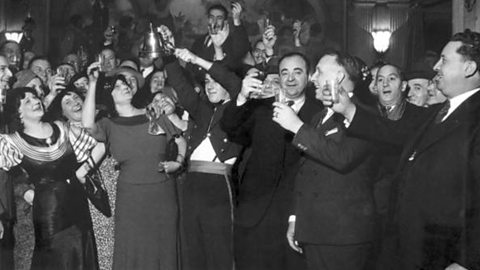Prohibition
Explore how racism, the fear of communism and criminality divided American society in the 1920s.
Prohibition was the name given to the period from 1920 to 1933 when the manufactureArticles or goods produced by workers in secondary industries from raw materials. and consumption of alcohol were banned across America by the federalPart of the government of the USA as a whole rather than relating to an individual state. government. Supporters of Prohibition saw it as a noble cause. However, it ultimately failed and had to be repealedWhen a law is officially withdrawn.
Reasons for Prohibition
There were several groups of people who wanted alcohol to be banned from American society. These included:
- Social campaignerSomeone who participates in an organised activity in order to bring about change in society. who worried about the social impact of drunkenness, crime, violence and domestic abuse.
- temperanceRefraining from alcoholic drinks. societies such as the Womanās Christian Temperance Union which opposed alcohol for religious and moral reasons.
- Some business leaders who believed that alcohol lessened the efficiency of their workers.
- The Anti-Saloon League which was the most successful group to organise politically to put pressure on the government to ban alcohol.
These groups that wanted to ban alcohol were known as ādriesā. Groups that wanted to keep the freedom to consume alcohol were known as āwetsā.
Passage of the 18th Amendment
President Herbert Hoover called Prohibition "the Noble Experiment". Its supporters believed that problems in society caused by alcohol could be solved by government legislation Laws made by the government.
CongressThe legislative body of the US government, made up of the Senate and the House of Representatives. agreed the 1919 Volstead Act to implement Prohibition. This became federal law through the 18th Amendment in January 1920. The amendmentA change made to the US Constitution after it came into force in 1789. made illegal the "manufacture, sale and transportation of intoxicating liquors", which were defined as drinks with at least 0.5 per cent alcohol by volume.
The failure of Prohibition

One clear problem was that Prohibition was very unpopular. Many people believed Prohibition went against the principle of personal liberty, so they ignored and disobeyed the law.
Bootleggers smuggled alcohol into America from abroad. Distillers illegally produced alcohol known as moonshine. Illegal bars and nightclubs known as speakeasyA bar that sold alcoholic beverages illegally during Prohibition in the 1920s. grew in popularity. In New York City there were twice as many bars in 1929 than before Prohibition began.
President Herbert Hoover set up a commissionA group of people who are asked to investigate something. to look at the impact of Prohibition. This became known as the Wickersham Commission. It reported in 1929 that Prohibition was not working. The reasons for this were:
- prohibition was almost impossible to enforce. In 1920, there were only around 1,500 enforcement agents. Their job was to catch and prosecute people who broke the Prohibition law. However, they were poorly paid and were often open to briberyGiving and receiving money or anything valuable as a way of influencing the actions of politicians or people in public in any office.
- many offenders went unpunished or were even protected by enforcement officials
- it was very difficult to prevent alcohol being smuggled into America, as the country has long borders
- many Americans did not support Prohibition and they still continued to drink at home or in speakeasies
However, the most serious problem was the growth of organised crime.
Organised crime
The biggest unintended consequence of Prohibition was the huge increase in organised crimeOrganised illegal activities. and the growth of powerful gangsters and gangs. For example:
- the illegal alcohol trade offered huge profits for gangs that could control this trade
- gangsters such as the notorious Al Capone, in Chicago, had reportedly earned around $60 million (around Ā£700 million today) by the mid-1920s
- gangs used violence to dominate key areas of the country in order to protect their profits. They would often murder members of rival gangs
- towards the end of the 1920s, there had been hundreds of gang-related murders in Chicago alone
Much of the criminal activity went unpunished as there was widespread corruptionDishonest behaviour. across the legal, justice and political systems.
To many people, it seemed that Prohibition was doing more harm than good. It was finally ended in 1933.